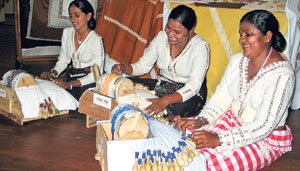
In the beginning...
“Hentley Garments Ltd pioneered the export of shirts in 1965 with the first ever shipment of shirts into Russia,” says a book titled the Textile History of Sri Lanka by E Pararajasingham. This first batch of garments left Sri Lankan shores under the Sri Lanka-USSR Bilateral Trade Agreement. But in 1968 when Hentley’s applied for permission to set up the first 100% export oriented garment factory to export to the US, the government refused. Hentley’s kept at it and got their permit a few months later and by 1978 when the economy was opened up, had already exported Sri Lankan garments to the US, UK, Canada, Hungary, Sweden and Russia. Hentley’s was not the only company to get into the export garment trade in the 60s. The Textile History of Sri Lanka identifies about 11 other “pioneers”. These include Bernard Boteju, Velona, Hirdaramani, Bentley Industries, Lanka Weaving Mills, Ceylon Dia Shirt Company, Candy Garments, Seylon Knit-Wear Industries, Noortex Garments, Maxims, and DM industries. Some of the names are still in business over 40 years later. However, the ready-made-garment boom started only after 1977 under export led open economic policies. By 2001 over 1,000 garment factories (1,061) were estimated to be in operation in different parts of the country.
The numbers started declining again towards 2004 with quota removals looming ahead. A 2004 headcount by the Labour Department and Oxfam found only 733 garment factories. But even now textile and garment exports account for nearly half of Sri Lanka’s total exports (46% in 2005, Central Bank Annual Report) to the world and the garment industry is the largest employer in the manufacturing sector providing jobs for nearly 300,000 people. Today garment factories produce clothes for brand names like Marks & Spencer, Gap, Tommy Hilfiger, Abercrombie and Fitch, Ralph Lauren, Speedo, Nike, Victoria’s Secret, YKK, Triumph, Kellwood and many more. A Sri Lankan factory manufactured Speedo’s Fastskin swimsuits for Olympic swimmers at the Athens Olympics in 2004. Sri Lanka has also made itself a name globally as a high quality lingerie manufacturer – a highly specialised area in the garment trade. Backward linkages Therefore to cut costs and deliver faster, garment factories are looking to source inputs from within the country and the demand for quality textile is increasing. Although Sri Lanka did have a thriving textile industry prior to liberalising the economy, textiles did not keep pace with the growth in garments. “The local textile industry was protected during the closed economic periods. So when the economy was opened up, it could not meet garment industry requirements for an export market. The textile industry could not meet quality requirements and other specifications,” says Pararajasingham, author of the Textile History of Sri Lanka and a former Chairman of the Textile Training and Services Centre. “We were producing 27 to 36 inch width fabric when the garment export industry needed 44 to 60 inch fabric. The technology could not meet export quality levels. The textile sector is also highly capital intensive. So when garment factories started, there was a shift of private capital from the fabric sector into the ready-made-garment sector. Meanwhile local fabric had to compete with imported fabric that leaked into the local market,” explains Pararajasingham. Another factor that drove the local fabrics out of the market was changing lifestyles of Sri Lankan consumers after the open economy. But total backward integration is not considered economically feasible for Sri Lanka. “100% backward integration is not feasible. But backward integration in fabric, particularly in the area of knit fabrics, dyeing, and finishing and domestic production of accessories, should be encouraged,” he said. The best business model says Pararajasingham is for garment factories and fabric manufacturers to form joint ventures. This move, he says, will share the risk and increase profits. |
| || Front
Page | News
| Editorial
| Columns
| Sports
| Plus
| Financial
Times | International
| Mirror
| TV
Times | Funday Times | ST - 1 || |
| |
Copyright
2007 Wijeya
Newspapers Ltd.Colombo. Sri Lanka. |
 Garment specialists trace the ready-made-export-garment history 40 years back to the 1960s. The first garment exports from Sri Lanka were not into the US or the EU, the two major markets today, but into Russia. It all began when the then Soviet Union showed an interest in buying made-in-Sri Lanka shirts.
Garment specialists trace the ready-made-export-garment history 40 years back to the 1960s. The first garment exports from Sri Lanka were not into the US or the EU, the two major markets today, but into Russia. It all began when the then Soviet Union showed an interest in buying made-in-Sri Lanka shirts.